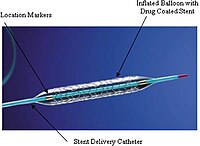
Reproductive outcomes and reproductive tract microbiota shift in women with moderate-to-severe intrauterine adhesions following 30-day post-hysteroscopic placement of balloon stents or intrauterine contraceptive devices: A randomized controlled trial
Sign Up to like & getrecommendations! Published in 2022 at "EClinicalMedicine"
DOI: 10.1016/j.eclinm.2021.101200
Abstract: Summary Background Intrauterine adhesions (IUA) develop in up to 20% of women with a history of abortion. After hysteroscopic adhesiolysis, balloon stents are usually placed for seven days to prevent recurrence. The efficacy of prolonged… read more here.
Keywords: balloon stents; trial; moderate severe; balloon ... See more keywords

A prospective randomized controlled trial comparing two different treatments of intrauterine adhesions.
Sign Up to like & getrecommendations! Published in 2020 at "Reproductive biomedicine online"
DOI: 10.1016/j.rbmo.2020.02.013
Abstract: RESEARCH QUESTION Intrauterine adhesions (IUA) are primarily caused by trauma to the endometrium, and hysteroscopy is presently the main treatment for IUA. However, high rates of post-operative adhesion re-formation remain a problem. In this study,… read more here.
Keywords: balloon uterine; intrauterine adhesions; uterine stent; adhesion ... See more keywords

Observation of the Auxiliary Treatment Effect of Low-Frequency Nerve Therapy Instrument after Hysteroscopy for Moderate and Severe Intrauterine Adhesions Based on Intelligent Medical Treatment
Sign Up to like & getrecommendations! Published in 2022 at "Journal of Healthcare Engineering"
DOI: 10.1155/2022/2929800
Abstract: Uterine adhesions are mainly manifested as menstrual changes in women of childbearing age and affect fertility. Resection of uterine adhesions can well restore the shape of the patient's uterine cavity and improve the patient's menstruation.… read more here.
Keywords: control; treatment; low frequency; intrauterine adhesions ... See more keywords

The Mechanism of Wnt Pathway Regulated by Telocytes to Promote the Regeneration and Repair of Intrauterine Adhesions
Sign Up to like & getrecommendations! Published in 2022 at "Computational and Mathematical Methods in Medicine"
DOI: 10.1155/2022/3809792
Abstract: Background Telocytes (TCs), a novel interstitial cell type in the reproductive tract, participating in pathophysiology of intrauterine adhesions (IUA). This study further investigates the hypothesis that TCs, a source of Wnt, promote the regeneration and… read more here.
Keywords: regeneration; expression; regeneration repair; promote regeneration ... See more keywords

The role of KDR in intrauterine adhesions may involve the TGF-β1/Smads signaling pathway
Sign Up to like & getrecommendations! Published in 2019 at "Brazilian Journal of Medical and Biological Research"
DOI: 10.1590/1414-431x20198324
Abstract: The aim of this study was to investigate the role of kinase-insert domain-containing receptor (KDR) in intrauterine adhesions (IUA) and its mechanism. The Case group consisted of 92 patients diagnosed with IUA, and the Control… read more here.
Keywords: expression; kdr intrauterine; kdr; intrauterine adhesions ... See more keywords

Three-dimensional structure micelles of heparin-poloxamer improve the therapeutic effect of 17β-estradiol on endometrial regeneration for intrauterine adhesions in a rat model
Sign Up to like & getrecommendations! Published in 2017 at "International Journal of Nanomedicine"
DOI: 10.2147/ijn.s137237
Abstract: Intrauterine adhesions (IUA) frequently occur after infectious or mechanical injury to the endometrium, which may lead to infertility and/or pregnancy complications. There are few effective treatments due to the complex function of endometrium and shortage… read more here.
Keywords: heparin poloxamer; intrauterine adhesions; hydrogel; endometrium ... See more keywords

Clinical evidence of positive correlation between intrauterine adhesions and chronic endometritis: a retrospective study.
Sign Up to like & getrecommendations! Published in 2023 at "European review for medical and pharmacological sciences"
DOI: 10.26355/eurrev_202305_32467
Abstract: OBJECTIVE This study aimed to analyze the potential correlation between chronic endometritis (CE) and intrauterine adhesions (IUA) with its associated risk factors. PATIENTS AND METHODS We retrospectively analyzed data from 131 patients who underwent hysteroscopic… read more here.
Keywords: severe iua; iua; chronic endometritis; correlation ... See more keywords

Protective Effects of Engineered Lactobacillus crispatus on Intrauterine Adhesions in Mice via Delivering CXCL12
Sign Up to like & getrecommendations! Published in 2022 at "Frontiers in Immunology"
DOI: 10.3389/fimmu.2022.905876
Abstract: Endometrial injury is the main cause of intrauterine adhesions (IUA), and there is currently no effective prevention and treatment. Immune cells play an important role in damage repair by sensing the change in the microenvironment.… read more here.
Keywords: lactobacillus crispatus; diabetic mice; engineered lactobacillus; mice ... See more keywords

Focus on the Primary Prevention of Intrauterine Adhesions: Current Concept and Vision
Sign Up to like & getrecommendations! Published in 2021 at "International Journal of Molecular Sciences"
DOI: 10.3390/ijms22105175
Abstract: Intrauterine adhesion (IUA), and its severe form Asherman syndrome (Asherman’s syndrome), is a mysterious disease, often accompanied with severe clinical problems contributing to a significant impairment of reproductive function, such as menstrual disturbance (amenorrhea), infertility… read more here.
Keywords: intrauterine adhesions; prevention intrauterine; iua; focus primary ... See more keywords

Abnormal hysteroscopy findings among a cross section of infertile Nigerian women
Sign Up to like & getrecommendations! Published in 2019 at "Nigerian Journal of Clinical Practice"
DOI: 10.4103/njcp.njcp_404_17
Abstract: Background: Intrauterine lesions are important causes of infertility. This study aims to evaluate the abnormal findings at hysteroscopy among infertile women seen in 2 new Fertility/Gynaecological Endoscopy units in Nigeria. Methods: A prospective study of… read more here.
Keywords: intrauterine adhesions; women abnormal; hysteroscopy; abnormal findings ... See more keywords